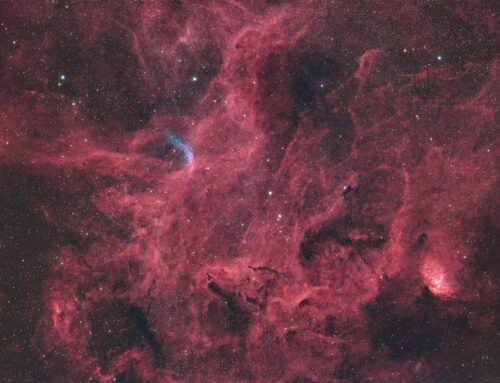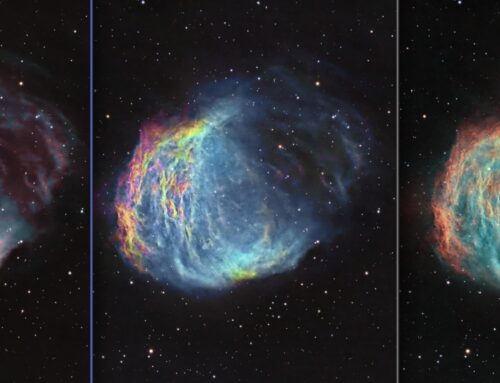NGC2174 and NGC2175
Click image for full size version
January 10, 2015; Astronomy Magazine Online Picture of the Day May 5, 2016
 NGC2174 is the red emission nebula in this image, also known as the Monkey Head Nebula, though I don’t know why. The nebula surrounds open star cluster NGC2175 and lies about 6,400-7,200 light years from us (estimates I have seen were all in this range). The nebula is considered a stellar nursery – a place where new stars are forming. This nebula is in the northern part of Orion, just below the feet of Gemini. Being in the winter Milky Way, it is quite rich with stars, which show a range of colours from red to blue based on their temperature (blue is hottest; red coolest).
NGC2174 is the red emission nebula in this image, also known as the Monkey Head Nebula, though I don’t know why. The nebula surrounds open star cluster NGC2175 and lies about 6,400-7,200 light years from us (estimates I have seen were all in this range). The nebula is considered a stellar nursery – a place where new stars are forming. This nebula is in the northern part of Orion, just below the feet of Gemini. Being in the winter Milky Way, it is quite rich with stars, which show a range of colours from red to blue based on their temperature (blue is hottest; red coolest).
Tekkies:
SBIG STL-11000M camera, Baader LRGB and Ha filters, 10″ f/3.6 ASA astrograph, Paramount MX. Guided with STL-11000’s internal guider. Focus with FocusMax. Acquisition, guiding and calibration with Maxim-DL. Image registration, integration and all processing in PixInsight. Shot from my SkyShed in Guelph, Ontario. Thin crescent moon – quite beautiful showing the old moon in earthshine. Good transparency and poor seeing throughout. Image Data acquired in March 2014.
8x5m R and G, 12x5m B, 20x5m L and 7x20m Ha, all unbinned frames (total=6hr20m).
Synthetic Luminance:
Creation and cleanup: The L, R,G,B and Ha masters were cropped and combined using the ImageIntegration tool (average, additive with scaling, noise evaluation, iterative K-sigma / biweight midvariance, no pixel rejection). DBE was applied to flatten the background.
Deconvolution: A star mask was made to use as a local deringing support. A copy of the image was stretched to use as a range mask. Deconvolution was applied (50 iterations, regularized Richardson-Lucy, external PSF made using DynamicPSF tool with about 40 stars).
Stretching: HistogramTransformation was applied.
Ha, R, G and B masters were cropped to match the SynthL and the R, G and B channels were combined to make an RGB image. Ha and RGB were processed with DBE, combined with the NB-RGB script, and Colour Calibration was applied. HistogramTransformation was applied, with the goal being to approximately match the brightness of the HaRGB to the SynthL image made previously.
Combining SynthL with HaRGB:
The luminance was extracted from the HaRGB image, processed and then added back into the HaRGB image as follows:
1. Extract luminance from the HaRGB image.
2. Apply LinearFit using the SynthL channel as a reference.
3. Use ChannelCombination in the Lab mode to replace the luminance of the HaRGB with the fitted luminance from step 2.
4. Use LRGBCombine to appl SynthL to the HaRGB image.
Final Processing:
HDRMultiscaleTransform was applied at a scale of 6 using a star mask to protect cores of bright stars. TGVDenoise was applied to luminance channel only with default settings, 300 iterations. LocalHistogramEqualization was applied to the nebula only.
Large-scale structures were isolated by subtracting the small-scale image from the SynthLHaRGB (no rescaling). Colour saturation and contrast were boosted on the large-scale image. Colour saturation was boosted on the small scale image. Then small-scale and large-scale images were added back together in PixelMath.
The DarkStructureEnhance script was applied to the nebula only. Stars were sharpened with UnsharpMask (0.8 px scale, 80% strength). Morphological transformation was applied to reduce stars size slightly. TGVDenoise was applied and contrast was adjusted.
Image scale is about 2.2 arcsec per pixel for this camera / telescope combination.







Leave A Comment